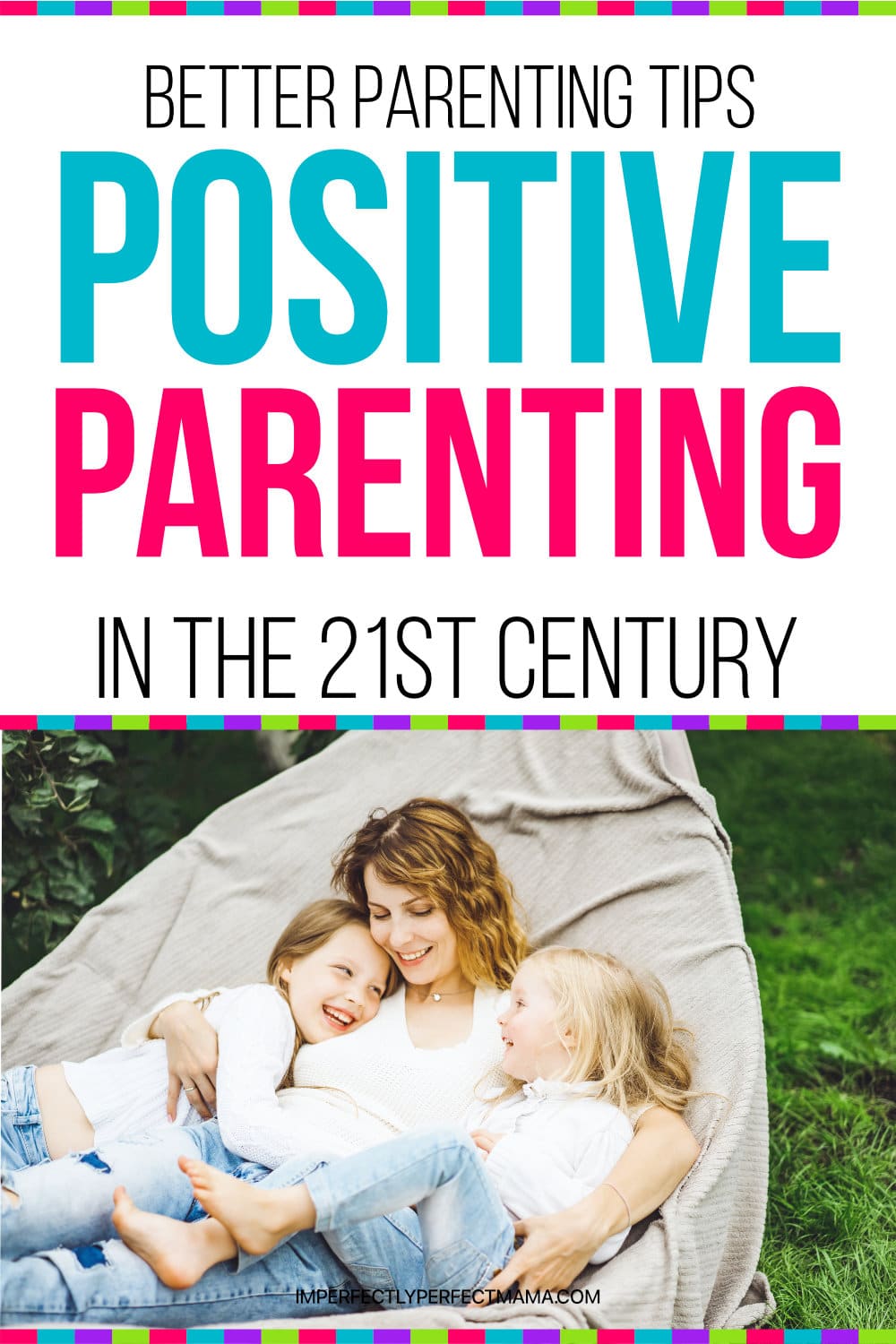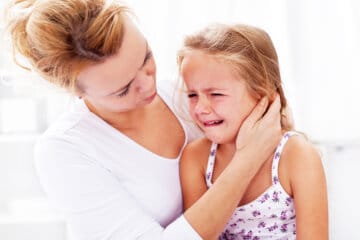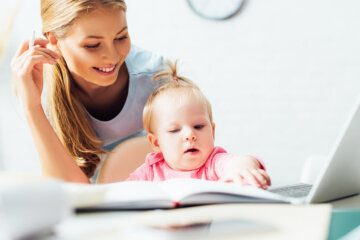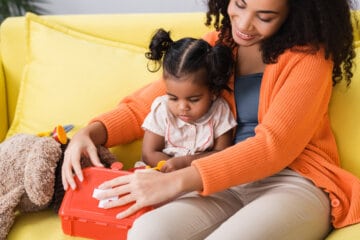Positive parenting in the 21st century is an incredibly different space from what parenting was like 30 years ago.

A number of moms can attest to the fact that they feel like many of the old techniques for parenting don’t work (or aren’t recommended) these days, and that they need a new and improved way of parenting.
This really hit home for me as a young mama to a 2-year-old (even as a teacher who was very experienced with small children) and it took a long time to work out how to bridge that generation ‘understanding’ gap!
Making daily (often every minute or two) decisions that felt intuitively right, but still maintained our family connection and expectations, was very hard as a young mom.
It’s even harder as you have more children and need to make different decisions based on your child’s temperament and level of development!
This post will share about being a positive parent in the 21st century, and some tips on how you can balance the traditional and the new in a healthy way that is best for your own family.
The Traditional Parenting Environment Many of Us Grew Up In
Kids could roam the streets more, spent more time outside, and school was very important but it was the main activity in a child’s week, rather than too many extra-curricular activities crowding kids’ hours.
Some moms were, in retrospect, as confused as some moms today on how to parent their children, resulting in relationship damage and hurt between parent and child.
(Some weren’t confused at all and did an amazing job!)
Many mothers were also still staying at home while their children were little, without work to focus on.
Traditional motherhood and parenting in the late 20th century often focused more on:
- Children are not the most important in the family-parents are
- They do what they are asked or else
- A mom’s job is working or doing housework-not playing
- Emotional confusion or ‘just don’t cry’ mentality
- Kids just eat what is there-because there wasn’t enough to waste
- ‘Screens’ weren’t a thing – it was just TV. There was an awareness that this was not healthy but screens weren’t everywhere, like today
- Mom fashion and style were really often just for moms who happened to be more focused in that direction. Style was more practically based
- Moms didn’t have as much external guilt or shame-based judgment from all around them!
- Families lived, in many cases, in smaller houses but with more outside space for children to run around
(Let’s clarify that this was not every parent or family, and there are some generalizations in that list, but basically.)
How Have Things Changed for 21st-Century Moms?
Many moms feel like they need to:
- Have a beautiful lunchbox filled with food that is visually pleasing
- Listen, communicate and understand our child-even when doing this with any child is not our forte (it’s OK to learn on the job)
- Work, whether full-time, part-time or ‘around the kids’ at home (now in isolation sometimes!!)
- Help our children learn to manage their emotional moments well and calmly
- Eat healthily to maintain the right body weight, shape and look like we haven’t had children at all
- Limit screen time, when it is often a tool to help us get things done in our busy work situations
- Look amazing with well-made, sustainable and ethically made clothing that means we fit in at work, school dropoff – and it must be at least a little stylish too!
- Have a lot of confidence, so they can know they’re doing the right thing with their children, even in the face of judgment
- Hold our own emotions in check, even in the face of screaming children, relationship breakdown, or hormonal moments (I know you’re hearing me…).
What’s the Problem with Modern Parenting?
Many moms feel like they can’t set boundaries with their children, or feel confused about how to actually manage the relationship between love and connection, boundaries, and independence.
This often results in families being more child-focused than is healthy, sometimes resulting in marriage issues, and usually in an entitled child who is less than happy to contribute around the home.
Not to mention ruining the confidence and sanity of the mother who is absolutely trying her best to do everything society says ‘she needs to do.’
It also can create problems with the child’s future relationships, because relationships, where everyone can contribute, are the ones that thrive and keep the love alive!
We all want our kids to have good social skills and understand interdependency as well as how to interact and depend on each other in a healthy, cooperative way.
Most parents want all these things to be a reality for their child, but many don’t know how to get there, how to bridge the gap between their reality and what they really want.
So Where Does This Leave Us?
It’s clear that both traditional motherhood and 21st-century motherhood have healthy and unhealthy facets.
So how can we be a positive parent in the 21st century – but not be constantly turned on the hamster wheel of busy modern motherhood so we become stressed and confused and overwhelmed?
Here are a couple of ideas:
Think about what you want your family, parenting, kids’ behavior, connection and your daily life to look like.
Using the two lists above is a great way to reflect on what you want in your own children’s lives. What facets should you highlight, and which should you drop off your expectation list?
Think about how to get to the connection and relationship you want with your child, and how this fits into how you live on the daily. Ask people, your own parents, your friends with older children.
Ask a parenting coach or your child’s teachers.
Don’t be afraid to ask!
This is like a new job, right? Asking questions is the way to knowledge, or at least a lot of information you can then sort out to find which ‘fits’ your parenting style and family.
Think about what your child actually needs from you.
Some kids are needier in some areas than others. Positive parenting means we take the time and make the effort to find that out so we can help our child grow in a healthy way.
Some kids will need more time from you, some will need you to give them space to work things out, and others will just appreciate a little note here and there in addition to a ‘normal’ connection.
This also covers areas of discipline and boundaries. (No, they’re not dirty words)
All children need boundaries, and they all need their parents to show them that their childhood is a safe space where they can learn to live and learn, without managing huge decisions and responsibilities that are really a parent’s job.
You alone know what is best for your child. Make it a priority to find this out and work it into your parenting-but remember to take it lightly, too.
No strategy works every single time, because kids are human and so are we.
It is possible to be a positive parent.
To lead your family with love, compassion and empathy while still managing boundaries and showing your family how to live a healthy, socially adept and meaningful life in the world they find themselves in.
Coming ‘through’ parenting with children who are true to themselves, are good citizens, who can contribute to their surroundings and build others up, is the main goal.
And, of course, have a great relationship with their parents too!
Positive Parenting in the 21st Century
Being a positive parent in the 21st century is still a hard job like it was for those who came before us.
It’s full of highs, lows and every action often brings a fresh question of ‘How do I manage this one?’
But these days you don’t have to do it alone.




2 Comments